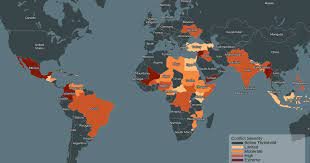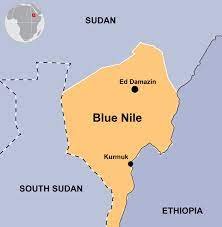The more you sweat in peace, the less you bleed in war.
Norman Schwarzkopf
War and conflict have nothing to do with peace and perseverance. Even though the world has seen two major World Wars’ and the destruction followed, yet the human race isn’t short of conflicts and wars. Here is a list of some very infamous conflicts of the year:
Israel-Hamas War:
The very long conflict between Israel- Hamas turned into a deadly war when Hamas militants’ attacked a rave festival in Israel, killing over 1000 people and abduction of almost 240 hostages. In retaliation the Israel forces bombed Gaza to pieces. Later the ground forces barged into Gaza for freeing the held captives and capturing the Hamas fighters.
The ongoing war called out as genocide by many has killed over 20,000 people and counting. Most of whom are minors and women. More than a million people have Gaza. Although the war is condemned globally and many nations including the UN agency has called for a ceasefire, but there seems no stopping of the bombardments.
Ukraine-Russia War :
This war entered 675th day today, escalated in February 2022 when Russia invaded Ukraine. Putin declared on February 21 that the Donetsk People’s Republic and the Luhansk People’s Republic, two autonomous regions of Ukraine under Russian authority, would now be recognized diplomatically as separate entities, deploying “peacekeepers” into these areas.
The number of Russian soldiers lost in battle was certified by the Ministry of Defense of Russia to be 5,937. Additionally, it stated that, 61,207 Ukrainian soldiers had died and 49,368 had been injured. The Ministry revised its claim of 383,000 killed and injured Ukrainian military casualties in December 2023.
Ethiopian Civil War:
As the Tigray War intensified in the spring of 2021, conflict started to arise in the two regions. The Ethiopian government is fighting both erstwhile allies and foes, such as the Amhara regional forces and non-state militias from Amhara and Oromia, in an attempt to strengthen central military control and address ethnic conflict in the two regions. The central government increased military operations in Amhara toward the end of 2023, and peace negotiations with the main Oromo militia broke down for the third time.
Ethiopia waged a battle with insurgents from Tigray, its northernmost area, which was ruled by the Tigrayan People’s Liberation Front (TPLF), between 2020 and 2022. One of the deadliest conflicts in modern times, it attracted attention from all around the world due to a number of accusations of war crimes, violations of human rights, and ethnic cleansing in Tigray. Approximately 600,000 civilians have died as a result of Ethiopia’s civil war, a startling figure considering the conflict’s brief two-year duration.
Syrian Civil War:
As of March 2023, estimates from several war monitors put the total number of dead in the Syrian Civil War upto roughly 613,407. The primary military confrontation in 2023 was not between rebels and the Syrian government, but rather between Turkish soldiers and various factions within Syria. Turkish forces persisted in attacking Kurdish fighters in the Rojava region towards the end of 2023.
The main armed conflict in Syria in 2023 was not with rebels and the government, but rather with Turkish soldiers and several Syrian factions. By the end of 2023, Turkish forces were still targeting Kurdish fighters in the Rojava region.
Armenia-Azerbaijan War:
In late September 2020, intense fighting broke out along the border between Azerbaijan and Nagorno-Karabakh, following a summer of cross-border raids. Thousands of soldiers and civilians lost their lives, while hundreds more soldiers from Armenia and Azerbaijan were injured. At first, both nations vowed to carry on fighting and refused efforts to hold talks and put an end to hostilities from the United Nations, the United States, and Russia.
On September 19, after Azerbaijan’s lightning onslaught and capture of Nagorno-Karabakh, separatist authorities declared that the enclave of ethnic Armenians will vanish on January 1, 2024. 80% of the people living in Nagorno-Karabakh fled to Armenia in less than a week when faced with the possibility of Azerbaijani authority. About 30,000 people died in the conflict, and hundreds of thousands of Azeris and Armenians were uprooted; the majority of them fled to Russia.
The Sudan Conflict:
5.6 million people have been forced to evacuate their homes and over 9,000 civilians have lost their lives as a result of the fierce internal fighting that is still ravaging Khartoum, the capital of Sudan. On April 15, 2023, during Ramadan, a conflict broke out between the competing factions of the Sudanese military government: the paramilitary Rapid Support Forces (RSF) led by Hemedti and the Sudanese Armed Forces (SAF) under Abdel Fattah al-Burhan.
The Darfur region and Khartoum, the country’s capital, have seen the most fighting. Around 10,000 people had been killed and over 1.5 million had left the country as refugees as of December 23, 2023, leaving over 5 million internally displaced. There have been numerous reports of civilian deaths in Darfur as a result of the 2023 Masalit massacres.
Myanmar Civilian war:
The military junta in Myanmar is fighting conflicts on several fronts throughout the country of Southeast Asia, posing the greatest danger to its hold on power nearly three years after its brutal takeover. An alliance of three potent ethnic rebel armies in the northeast of the country launched Operation 1027 in late October, and it has since sparked a national campaign to seize control of towns and regions in Myanmar’s north, west, and southeast.
Since October 27, the conflict has resulted in nearly 200 civilian deaths and 335,000 fresh displacements, according to the UN. For decades, a civil war has raged in Myanmar between the country’s numerous ethnic armies and successive military governments. However, the nation’s opposition to army chief Min Aung Hlaing’s February 2021 coup, which toppled Aung San Suu Kyi’s democratically elected government, is what led to the most recent uptick in hostilities.
The Nigeria Conflict:
President Mohamed Bazoum of Niger was overthrown and taken into custody by the presidential guard following a coup d’état that took place on July 26, 2023. After verifying the coup’s success, General Abdourahamane Tchiani, the Commander of the Presidential Guard, declared himself the head of a military junta and formed the National Council for the Safeguard of the Homeland.
The jihadist insurgency in Niger, which is being directed by Al-Qaeda, the Islamic State group, and Boko Haram, was sparked by the Islamist insurgency in the Sahel, which has drawn the involvement of the United States, France, and numerous other nations and entities.Turkey, France, and the US have all maintained bases there. It left Mali and Burkina Faso in 2022 after several military takeovers, and it thereafter became the center of French counterterrorism efforts.
According to a Zamfara State government study from August, between 2011 and 2019, 190,340 people were relocated, 25,050 children were left orphaned, and 4,983 women became widows. The study also stated that 3,672 persons were kidnapped during this time, and bandits were paid over 3 billion naira (US$6.8 million) as ransom.
Burkina Faso Civil War:
Burkina Faso’s human rights and security situation markedly deteriorated in 2021 as attacks and atrocities by armed Islamist groups increased, state security forces and pro-government militias continued to kill people without permission during counterterrorism operations, and the humanitarian situation worsened.
Demonstrations demanding an end to the slaughter were sparked by the violence, which included the June massacre of over 135 civilians in Solhan, the bloodiest atrocity in the nation since the start of armed war in 2016. After criticizing the government’s response to the increasing insecurity, a number of activists and political opposition members were interrogated or placed under arrest.
Approximately 237,000 people were forced to leave their homes as a result of attacks by armed groups. About 1.4 million people, or 6% of the population, have been internally displaced.
Blue Niles Clashes:
The ethnic composition of Blue Nile State is diverse and includes the long-established Hausa community, who have historically endured prejudice and were frequently viewed as aliens. Political factors, particularly the deeds of leaders such as Malik Agar, contributed significantly to the intensifying tensions.
Clashes between the Hausa and the Funj and Berta peoples in July, September, and October of 2022 resulted from land conflicts in the Blue Nile state in southeast Sudan, specifically the disputed creation of a Hausa emirate in Blue Nile State. Hundreds of civilians were killed in a series of attacks and assassinations that continued until the violence stopped in January 2023.
Many people were killed in these skirmishes, which also resulted in widespread displacement and the declaration of an emergency in some areas of Blue Nile State.
During the battle, there were about 600 civilian deaths and between 211,000 and 235,000 civilian displacements. The Sudanese government implemented policies to fight racism and hate speech in an effort to lessen future clashes. Leaders of the tribes also ratified accords meant to put an end to fighting.

















